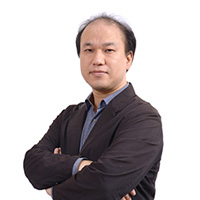Teaching ‘digital natives’ to pursue knowledge in a creative way
Kim Hyeon, an expert on digital humanities, showcases the potential of convergence and digital storytelling for high school students
By Yang Sung-jinPublished : Sept. 29, 2019 - 17:51

Drawing and retaining the attention of high school students armed with smartphones in a big class is not an easy task. However, Kim Hyeon appeared relaxed and confident in delivering a special lecture on digital storytelling to students at the art center of Hana Academy Seoul (also known as Hana High School) located in Jingwan-dong, Seoul, Wednesday.
His secret was the creative mix of digital technology and humanities knowledge in a way that captures and stimulates the curiosity of students.
Kim, professor of cultural informatics at the Academy of Korean Studies, presented a set of new ideas during a special lecture titled “Digital Storytelling: Study of Humanities in the Hyper-Connectivity Period.” Unlike other lectures based on textbooks or one-way presentations, he asked students to use their own smartphones to browse a Wiki-style online page in which all the lecture notes and related hyperlinks were prepared.
After explaining a series of interrelated historical facts and figures of the Joseon era through digital archives and intricate Wiki-based content, he stressed the importance of developing a new way to pursue knowledge: “This way, you can follow a chain of information in numerous directions, depending on your interest and curiosity.”
Kim, a leading scholar in the field of digital humanities, told students that text-based knowledge is now getting converted into a massive reservoir of data that can be read and interpreted by computers through artificial intelligence.
He is spearheading the introduction of new education programs based on digital curation, involving ontology design, Wiki content generation, data visualization and hyper-content production.
For today’s students who are called “digital natives,” Kim said, coding education is part of efforts to acquire essential skills to piece together digitalized knowledge components to ask new questions and come up with fresh solutions in the hyper-connectivity era.
Kim said visualizing a web of relations is the first step to build such creative perspective. He presented the life and music of Paganini as an example along with a visual map showing how specific elements involving the violin virtuoso are interrelated with each other.
As a demonstration of convergence between humanities and arts, he devoted the latter half of the two-hour lecture to a mini classical concert where the student orchestra members and three professional artists from Orfeo Ensemble Society staged a joint performance.
Kim Jung-geun, Korean history teacher at Hana Academy Seoul who organized the special lecture, said it was part of the school’s special curriculum on convergence between humanities and science.
“The lecture was originally designed for about 30 students, but since the topic is so interesting and professor Kim Hyeon’s lectures are highly regarded, we have accepted all the students who want to know about digital humanities,” he said.
Surpassing expectations from teachers, the lecture drew more than 150 students, some of whom asked thought-provoking questions after the live concert was over.
Both students and teachers seemed drawn to the visualization techniques applied to humanities knowledge and the way such data and multimedia are put together to create a set of digital archives as well as a new type of digital storytelling.
By Yang Sung-jin (insight@heraldcorp.com)


![[Weekender] AI is silently changing our work: 7 professionals share how](http://res.heraldm.com/phpwas/restmb_idxmake.php?idx=644&simg=/content/image/2024/11/07/20241107050847_0.jpg&u=)






![[What to Watch] Three classic Korean fall films you should watch this month](http://res.heraldm.com/phpwas/restmb_idxmake.php?idx=644&simg=/content/image/2024/11/07/20241107050844_0.jpg&u=)








